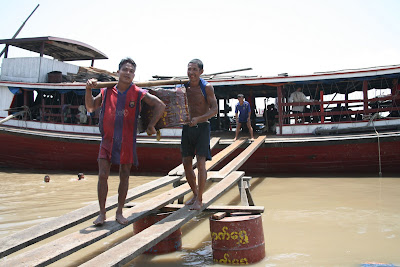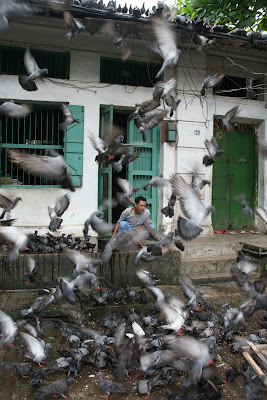
Mandalay. Mandalay is another stop on the tourist circuit in Myanmar. Located in the geographic center of the country, the surrounding area is home to several ancient capitals. The city itself was once a major center for the British empire in Myanmar and is now experiencing a flood of Chinese influence which can be seen in new buildings and cuisine. We decided to check it out.

We began our journey by bus from Pagan to Mandalay. The journey took about 8 hours and our bus only broke down once. Pictured above are some of our fellow passengers trying to cool the bus off.

Though Pagan was excruciatingly hot, Mandalay for some reason seemed even hotter. Here is Max sweating so much. We arrived in the afternoon and decided to grab some tea at a local tea shop. In Myanmar, tea shops are found everywhere and are a place for hanging out and passing the time for many unemployed men.

There are a couple of tourist guesthouses in Mandalay. This was the road to one. We learned that if a street is getting repaired in a city, it is usually the undertaking of the citizens who live on that block and not the government's responsibility. Apparently the inhabitants of this street had spent years saving money to rebuild their road and the project had just begun.

Here is Max with Par Par Lay of the famous "Moustache Brothers Comedy Troupe." The Moustache Brothers consist of a group of three brothers: U Par Par Lay, U Lu Zaw, and Lu Maw. Lay and Zaw were imprisoned for 7 years to a labor camp for their politically volatile routine performed at Aung Sung Suu Kyi's house in the lead up to the 1996 elections. According to the Lonely Planet, the Lady reportedly enjoyed the show and laughed uproariously at the famous screwball routine. The Moustache Brothers used to tour the country, performing their routine at weddings, festivals, and local ceremonies. Nowadays the government has confined their performances to their tiny house and it is only legal for foreigners to attend the nightly routine. And attend they do. The Moustache Brothers are a "must see" attraction in Mandalay.

A Photo of the Moustache Brothers and The Lady is proudly displayed on the wall of their home/performance space. Located in the southern quarter of Mandalay, The Moustache Brothers provide one of the few chances for tourists to see traditional Burmese dance and comedy in this once thriving theater district.

Par Par Lay was most recently arrested in 2007; it was rumored that he was involved in an antiques smuggling operation, but this is unconfirmed. The brothers simply state that he was arrested and most foreigners assume it was once again because of dissident political activity. Though we were initially really excited to see this performance because of their outstanding hype and the knowledge that they continue to speak out against the government, we came away with mixed reactions. First of all the show is painfully unfunny and very awkward to watch. Secondly, the show costs about 8000 Kyat each which is $8. The price doubled in 2 years, and before that the show used to be free. Though in the States an $8 show would be a steal, in Myanmar it is extremely expensive. We began to wonder whether or not the Moustache Brothers had to pay off the same government that they mock so openly. We were also really confused as to how the operation continues under the nose of the SPDC, considering the government has arrested these members many times and knows where they live and what they do. What is clear is that they are capitalizing on tourists' desire to help democracy activists for better or for worse.
Picture removed for subject's security
Our friend, who shall remain nameless just in case an SPDC member figures out how to use a computer. Our friend, who we will call Alex was a cycle rickshaw driver that Kara met at a tea shop the first morning we arrived to Mandalay. He struck up an interesting conversation and Kara and him clicked. He asked if we wanted to meet the next day to hang out and we agreed. It was the best decision we made in Mandalay, for he taught us so much from small Burmese phrases to the cost of rent for an average citizen. For example, Alex's rent is about $19/month. It increased by $5 in the last year which has been extremely difficult for him. He makes approximately $3/day on a good day. He can eat for about $2/day. He is also trying to put his daughter through school, and must support his grandfather who lives with him and is too old to work. His wife was not in Mandalay at the time that we became friends as she had returned to her village to ask her parents for a loan. Alex never asked us for anything and gave us all he could. He is also very open with how his life had been directly affected by the regime. Alex is a kind hearted and extremely intelligent person. Here we are after wandering around on our first day.

Alex took us to the riverfront which is essentially a shanty town. Goods are floated in from the northern states such as charcoal, timber and sugarcane.

These guys REALLY wanted Kara to take their picture. Here they are, moving barrels of raw sugarcane off the barge onto the main land.

When we first saw these barrels we thought it was sewage or something. Alex quickly explained to us that this is raw sugarcane.

Small street children and local kids living in the shanty towns collect over spilt sugarcane throughout the day from the ground. We assume they resell it or use it themselves for cooking.

Can you imagine eating this?

We did, but after it was thoroughly boiled. Alex lives in a sugarcane factory complex, which sounds very large but is actually just 2 big sheds. Alex took us back to his house and factory area where we saw what happens with the sugarcane after it leaves the barge. Seen above is the cooling process which takes place after the sugarcane is boiled.

Then a small assembly of workers, seen here, pull the cooled sugarcane into large, ropey bundles. The women cut and pack the sugarcane into the final product that is then sold to villages in the area.

Standing over the bridge near Alex's house, we looked down at the water (seen above) and found it difficult to take in the harsh reality of our new friend's life. He explained to us why he had become a cycle rickshaw driver. He used to work in a newspaper printing press back in the 80s, but then was fired along with the whole publication when the government (then known as the SLORC) banned independent publishing. He was unable to find another job for almost three years and finally resorted to the backbreaking and low paying work of cycle rickshawing. There are thousands of cycle rickshaw drivers in Mandalay with similar stories and equally grim challenges to face everyday. Competition is fierce and fares are very low. He used to be able to support his family and even make trips to Thailand less than 20 years before. He showed us pictures of a better time, when his face was full and healthy looking.

After lunch, Alex took us to Maxwell hill. Remember Maxwell hill in Malaysia? Same guy. The path up the hill is paved with steps and leads to a nice panorama of the city and countryside. Along the way are several giant Buddhas, each one larger than the last. Here is the final big Buddha.

More Buddhas. The next day we met Alex again to explore some more. This time we rented bikes and followed Alex's lead throughout the chaotic traffic This is the Mahamuni temple where Mandalay's most famous and most gold covered Buddha image resides. It has been gold leafed so many times that it's surface is no longer smooth but bubbly under a froth of devotional decoration. The image is particularly holy for Burmese from the Rohingya state. The temple also houses several statues that were stolen by the Khmers (Ancient Cambodians) and then stolen back by ambitious Burmese raiders several centuries later.

Outside the main viewing area of the Buddha lies a collection of images from a major SPDC visit to the shrine. Seen here is General Than Shwe, current dictator of this military junta. The generals are very conspicuous in their contributions, spending millions of kyat building and decorating temples throughout the country. As one article in the Irrawaddy opines they are following an ancient merit making tradition whereby Burmese kings built temples to atone for the wars and destruction they had caused. In addition to metaphysical motivations, the merit making goes a long way in securing political support from the devout population.

Later that day we rode out to the ancient capital of Amanpura, which ended up being a 15 km away. The scenery was beautiful riding out there; watching the city life slowly change into small villages lining the dirt road was a highlight of the trip. Kara stopped for a while to watch the water buffalo walking along the banks of the river while Max and Alex rode toward the oldest and longest teak bridge in the world.

We walked on the teak bridge along with monks, other tourists, and locals who all came to enjoy the sunset and serene view.

It was really hard saying goodbye to Alex. We will never forget him and hope to come back to visit him in different circumstances. We gave him a copy of Upton Sinclair's "The Jungle" to read in hopes of giving him inspiration that desperate labor conditions can, do, and indeed MUST change. If you are reading this and are thinking about going to Myanmar, we would like to get you in touch with Alex. He is one of the most amazing people we met during our time here.

We left Mandalay with a more complete picture of every day life of the Myanmar people and our hearts were all the more heavy for it.
To Alex, we will never stop thinking about you.
Kara and Max

















































